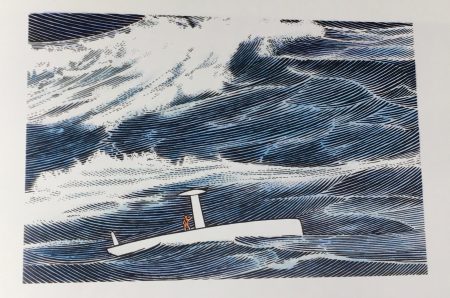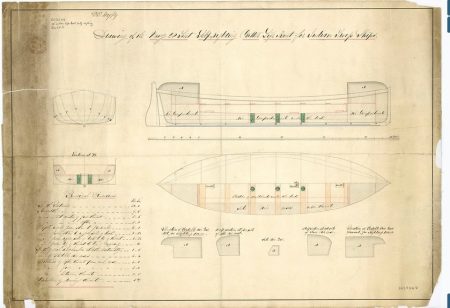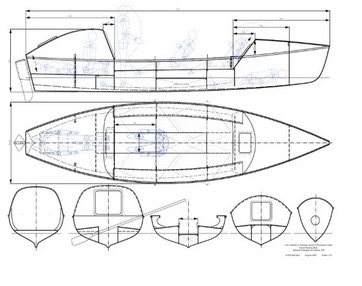More beam, draft and lead increase stability and most sailors wants plenty of stability.
Why then do I eschew beam, draft and lead and instead favor narrow, shallow draft boats that lack much ballast?
Everything is a compromise, cruising boats more so than many things. I look at the intended use, the whole picture. I consider many aspects of cruising before committing myself.
Beam increases stability but reduces its range. Beam is very useful at small angels of heel but catastrophic when the boat heels more than 120 – 140 degrees because then the beamy boat gets negative stability it flips over and takes up a stable upside down position. An extreme example of this is the catamaran. A beamy boat is like a floating 2X4 plank it will not come back if you flip it. It is stable on its two flat sides.
Draft reduces cruising range. A boat with much draft cannot cruise shallow water. Same of the nicest cruising is in shallow water. I do not like to end up upside down. I do not like to limit myself to deep water sailing. It is as simple as that. Thats why I like slender boats with small draft.
I also like an easily driven boat. Lead and beam increases resistance. Rules and regulations have for hundreds of years taxed length, therefore boats have become fat rather than long and narrow. The more bureaucratic a society is the fatter its boats are.
When you compare fat and slender boats of equal weight it is evident that the long narrow boat slices through water with much less resistance than the fat one. You can confirm it with a simple experiment. Drag a hull through the water the normal way, then try to drag it with its beam at right angles to the direction of the movement and you will immediately feel how the resistance increases. It’s not hard to understand that the boat with the smaller the cross sectional area creates the less resistance as it has less water to push aside.
Common is to build boats that are 3 beams long. I favor boats that are 6 beams long because when the two boats sail at the same speed the 6 beams long boat sails at a lower Froud number. It is not so close to its hull speed and therefore it creates a fraction of the resistance of the fat one. That is basic fluid dynamics.
In consequence the slender boat needs a fraction of the sail area to propel her. With less sail area the healing moment is smaller thus the long boat needs a fraction of the short boats stability. So there you have it. By reducing beam you increase stability. It is important to look at the whole picture, its basically economy of stability. Its balance between income and expenditure. A few years ago I earned more than General Motors not that I earned much but they were losing money.
If you are not familiar with Froude numbers there is a more detailed explanation of that and my idea of the low energy boat on my website at MANIFESTO.
With my low energy boats I do not need much stability but I am thrifty therefore I like a hull shape that maximize it.
So what is stability? Most people realize that it has to do with beam draft and ballast. They therefore design beamy boats that have a lot of lead low down in a ballast keel.
Thats part of the answer, but only a part.
Stability is a righting moment. Its arm is the horizontal distance between the center of the boats gravity and her center of buoyancy. The force of gravity and buoyancy are equal. The product of the length of the righting arm and the force is the boats stability.
On a catamaran the righting arm is very long therefore catamarans have a lot of stability even without any ballast at all.
I have known many world leading multihull designer including Dick Newick, James Wharam and Nigel Irens. In fact 1975 – 1976 I was Dicks assistant.
I like the way multihulls achieve stability without ballast. I therefore design my hulls to achieve stability by the use of buoyancy rather than ballast. I design my boats so that the center of buoyancy moves fast and far to lee with small angels of heel.
The higher the hulls center of buoyancy is located the further it moves to lee when the boat heels.
From this follows that a square, boxlike midsection with a flat bottom is best for initial stability.
An advantage is that a boxlike midsection gives the most stowage space inside the boat. A further bonus is that the flat surfaces dampens out rolling.
If that idea is so good why is it not used more? The answer is that many boats are big and flat surfaces on big boats is not a good idea. It makes them pound and no-one likes a lot of noise. Big boats are therefore round bilged to move with less noise. Convex surfaces are also stronger than flat ones.
Luckily my small boats makes no noise because the surface of their flat bottom is not large enough also a small boat do not have problems with strength.
Stability has two roles to play on a boat, the one we all are familiar with is to keep the boat from healing too much so that the sails can convert the wind to a propulsive force efficiently. The second function of stability is to provide safety in heavy weather so that the boat can come back on an even keel after a wave have capsized her.
Safety gear is a drag and an expense most of the time, but when they are needed they safe lives. Most production boats have a positive stability range up to 120 – 140 degrees of heel. That is not enough for me because when most boats heel more their stability becomes negative and they end up in a stable undesirable upside down position.
More about that in my manifesto.

A deep keel is no guarantee for a self-righting boat.
Gerry Roufs an acquaintance of mine capsized his boat in the Vendee Globe race 1996 – 1997. The boat never righted herself despite that huge waves were battering her for many months in the Roaring Forties. She had a ballast bulb of several tons and a draft of about 4 meters. The boat ended up on the Patagonian rocks. Gerry was never found. In the same race other similar boats also ended up in stable upside down positions.
As a consequence of the tragedy the boats now have to be built with a convex deck and a canting keels. That gives the desired stability range of up to 180° heel but that technology is so expensive and complicated that it cannot be used on production boats.
I do not agree with deep ballast keels. There is a smarter way for a small cruiser like mine. I achieve a stability range up to 180° with the help of buoyancy.
Buoyancy is cheap it is light and it involves no moving parts. I achieve this by having a beam to height ratio of about 1:1 and by keeping the center of gravity low with the help of a strong bottom and stowing water food and the necessary gear low down. I keep my water in 5 liter jerrycans. If at the end of a voyage I find that I lack stability I can always fill them up with saltwater and store them at the windward side but I have never had to do that.
The idea of using buoyancy to create a self-righting boat is not mine. That is idea much older than the ballast keel. Pulling lifeboats have been using it for hundreds of years. It is a well-tried concept that works well. Today all of the ocean rowboats are using it.


To visualize the idea imagine a hull with a flotation device on deck something like styrofoam or empty barrels.
When you turn her upside down the flotation device displaces water. That rises her center of gravity and she becomes unstable. The gained potential energy then brings her back on even keel with a splash into a position of the lowest energy.
It is simple, childlike engineering, almost everyone understands it. If you do not, convince yourself by do experimenting with models.
I have already mentioned that a slender hull makes for an easily driven boat that do not need much sail area to propel her. By placing that sail area close to the deck the heeling moment is reduced to even less. In contrast production boats have high triangular sails. It is hard to imagine a set up that heels a boat more.
By distributing the sail area along the boat on several masts the healing moment is even more reduced. With that achieved the boat can be made even lighter that reduces resistance further and so on in a good circle.
But the grown ups say that a high aspect ratio triangular sail is more efficient than a low aspect square sails.
To that I answer that the sails efficiency depends on the angle of attack.
One aspect ratio is not optimal on all points of sailing. If your choice is to race and sail close to the wind I agree with the grown ups. At that point of sailing you should chose the high aspect ratio because it is best for a given area.
However my kind of sailing often on a broad reach when I can ease the sheets low aspect square sails shine. With a free wind my sails are 50% more efficient than the tall racing ones.
There is more on rigs in my post: ” Rigs”.
Like most cruisers I have studied the worlds wind patterns and sail mostly with fair winds. Triangular sails are developed for racing boats to get a good rating on a rule when they sail to windward. They not good for small cruising boats. If you are cruising do not use tall rigs.
Buoyancy and shallow draft is lighter and cheaper than deep draft and ballast. It waste less non renewable resources.
Simplify and simplify again because that leads to create cheap functional uncomplicated boats. That in turn helps us in a small but important way to create a more sustainable world.
As always please support my research by donating on Pay Pal or Swish
Regards Yrvind
